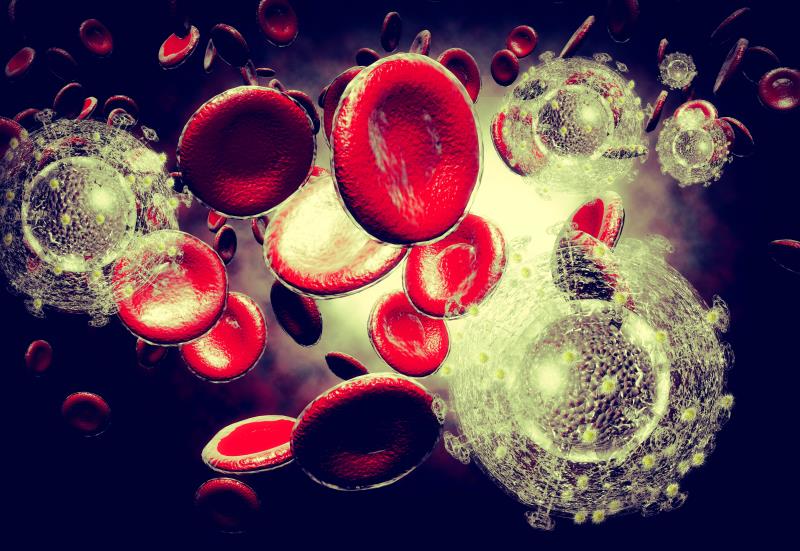
The angiotensin receptor blocker (ARB) losartan did not improve inflammation, T-cell immune recovery, or fibrotic activity among older persons living with HIV (PLHIV) and viral suppression, according to data presented at CROI 2020.
“It has been well-established that among PLHIV, ongoing inflammation despite viral suppression contributes to a broad spectrum of comorbid disease events,” said study author Dr Jason Baker from the Hennepin Healthcare Research Institute in Minneapolis, Minnesota, US, during his virtual presentation of data from the LIFE HIV* study.
“During continuous antiretroviral therapy (ART), higher levels of [the inflammatory plasma biomarker] interleukin(IL)-6 … predict the risk for a wide spectrum of end-organ disease events over 8–9 years of follow up,” Baker continued. Persistently low CD4+ T-cells, which signify incomplete immune recovery, is another important disease element tied to increased risk for AIDS events. [AIDS 2010;24:1877; AIDS 2008;22:841] “Up to 15–20 percent of PLHIV do not fully reconstitute CD4+ T-cells in blood despite viral suppression, hence the associated increased risk for events such as cardiovascular disease and cancer,” he added. [CID 2007;44:441; JAIDS 2008;48:541]
As ARBs have been shown to mitigate pathways influencing systemic inflammation, immune recovery, and fibrosis, the team hypothesized that losartan may have the potential to downregulate these mechanisms in this setting. However, data in both analyses suggested otherwise, noted Baker.
In the LIFE HIV trial comprising 108 patients (median age 56 years, 96 percent male, median baseline IL-6 level 1.1 pg/mL, median baseline CD4+ count 408 cells/µL) randomized 1:1 to receive oral losartan 100 mg or placebo, there was no evidence of a significant treatment effect on the IL-6 level with losartan at 1 year (effect estimate, 0.6 percent, 95 percent confidence interval, -14.7 percent to 18.7 percent). [CROI 2020, abstract 84]
CD4+ T-cell level also did not improve with losartan at 1 year (mean change from baseline, 15.1 cells/µL; p=0.43).
Apart from the reductions in systolic and diastolic blood pressure (BP) with losartan (6 and 5 mmHg, respectively), these findings failed to show improvement in IL-6 level or T-cell immune recovery, which correlate with previous evidence. [J Gerontol A Biol Sci Med Sci 2019;74:1612-1619]
While there appeared to be a trend towards more frequent adverse events (eg, fatigue, dizziness, and malaise) with losartan vs placebo (18 vs 9 events; p=0.06), these were largely attributable to the BP-lowering effect of the active drug.
Lymph node tissue analysis
In a separate analysis that pooled data from LIFE HIV and RTF-HIV**, 95 PLHIVs (median age 51 years, 97 percent male) were randomized 1:1 to receive losartan 100 mg or placebo. Of these, 70 participants underwent inguinal lymph node (LN) biopsy at baseline for LN tissue analysis. The analysis sample comprised 50 LN tissues evaluated at 12 months. [CROI 2020, abstract 277]
Compared with placebo, treatment with losartan did not elicit any improvement in LN CD4+ T-cells at 1 year (mean, 26.5 vs 27.1 percent area; p=0.79), thus reinforcing the initial findings from LIFE HIV.
Evidence shows that fibrosis (ie, collagen deposition) within the LN parafollicular zone impairs immune reconstitution and influences the depletion of naïve and central memory T-cells. [Clin Vaccine Immunol 2006;13:556-560; J Infect Dis 2008;198:456-464; Semin Immunol 2008;20:181-186] The lack of significant difference in LN collagen between the losartan and the placebo arms at 1 year (mean, 24.4 vs 25.4 percent area; p=0.58) reflects the inability of losartan to inhibit fibrosis.
“[Taken together,] losartan treatment in addition to ART is unlikely to reduce inflammation-associated comorbidities [in this setting] to a clinically meaningful degree, beyond the established benefits from lowering BP,” said Baker, who also co-authored the pooled analysis.
Given the importance of restoring health among PLHIV, further exploration is warranted to identify novel treatments that may mitigate lymphatic tissue fibrosis and improve immune reconstitution, he added.